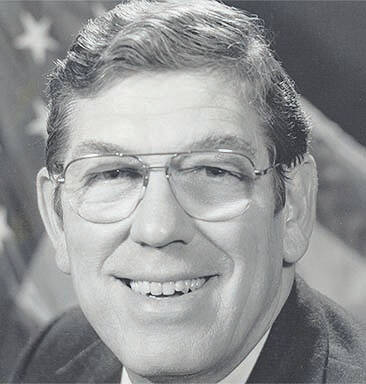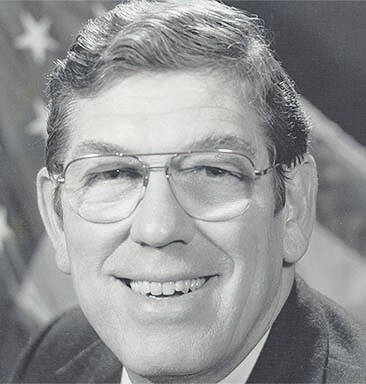

Clarence J. “Bud” Brown, Jr., a nine-term Republican congressman from Ohio who was highly influential in U.S. energy and economic policy, died peacefully at home surrounded by his family on the evening of January 26, 2022 in Urbana, Ohio. He was 94. Known to all as “Bud,” Brown also ran for governor of Ohio and, after losing that race, served as deputy secretary and acting secretary of the Department of Commerce under President Reagan.
Bud Brown helped shape major new laws passed in response to the national energy crisis in the 1970s as the ranking Republican on the U.S. House of Representatives Energy and Power Subcommittee (of what was then the Interstate and Foreign Commerce Committee and is now the Energy and Commerce Committee). As the Congress, which was controlled by Democrats, debated President Carter’s legislative proposals in response to the Arab Oil Embargo and the attendant long lines and rationing at U.S. gasoline stations, the two parties were deeply divided.
Brown assembled an effective coalition of Republicans and oil-state Democrats whose state interests aligned with the Republicans’ free market principles, which induced the subcommittee chairman, the late U.S. Rep. John Dingell, D-Mich., to compromise with Brown in order to get a majority vote on key provisions of the proposed legislation.
As a result, Brown had a major impact on a series of new laws – the Energy Reorganization Act of 1974, the Energy Policy and Conservation Act of 1975, the Department of Energy Organization Act of 1977 establishing the Department of Energy, the National Energy Act of 1978, and the Emergency Energy Conservation Act of 1979 – that completely changed the U.S. approach to energy policy.
Brown and Dingell battled for every vote on every amendment of every bill in committee and on the House floor, and the stakes often were high. Their epic rhetorical and procedural battles enlivened each debate, but at the end of the day when the gavel came down, they often were seen walking away from the committee room, arm-in-arm, joking and laughing. They disagreed on policy, but they highly respected each other and the institution in which they (and their fathers) served.
The same level of civility and willingness to compromise came into play when Brown served as ranking Republican on the House-Senate Joint Economic Committee. When the late U.S. Sen. Lloyd Bentsen, D-Tex., chaired the committee, the two worked together to win passage of the first two unanimous Joint Economic Committee (JEC) reports, in 1979 and in 1980 (“Plugging in the Supply Side”). These helped to popularize the then-new idea of reducing taxes and regulations to encourage investment, productivity, and wage growth, while trimming government spending and money-creation to fight “stagflation.”
President Reagan’s Economic Recovery Tax Act of 1981 and budget submissions, and the late Federal Reserve Board Chairman Paul Volker’s management of the money supply at the Federal Reserve Board, put those policies into action and contributed to non-inflationary economic growth. The bipartisan JEC reports also emphasized the importance of considering the economic consequences of changes to the tax system, a concept that underpins the current practice of reporting budget effects of tax changes on a “dynamic scoring” basis, which includes the revenue effects of changes in GDP and employment.
Brown was known for his sometimes pointed, but often good-natured and humorous jousting with witnesses at Congressional hearings. Once, when the House Government Operations Committee was hearing from a particularly puffed-up General Accounting Office witness, who advanced the idea that if Congress would restrict access to certain types of energy, it would have no impact on pricing. When it was Brown’s turn to ask questions, he said with a perfectly straight face, “I respect your expansive view of the powers of Congress, sir, but despite all of our rhetoric, Congress does not have the power to repeal the law of supply and demand.” The room erupted in laughter and the witness turned crimson.1
On another occasion, Brown sarcastically remarked in response to what he considered to be a counterproductive proposal to increase government intervention in the energy markets, that perhaps it would make more sense if Congress simply repealed the laws of physics so that oil would just bubble up out of the ground.2
Brown represented the Seventh Congressional District of Ohio as a Republican in the U.S. House of Representatives for 17 years, from 1965 to 1983. He was first elected in a special election to succeed his father, Clarence J Brown, Sr., who had represented
the district for 27 years, from 1938 to 1965. The younger Brown was known for his constituent service and spent nearly every weekend in his congressional district, taking to heart his constituents’ needs.
Bud Brown was a strong supporter of Wilberforce University and Central State University, two historically black universities (HBCUs) in his district. His efforts led to passage of a law in 1980 establishing a National Afro-American Museum and Cultural Center in Wilberforce, Ohio. The museum, which opened in 1988, is one of the first national museums dedicated to African-American history.
He also was an advocate for environmental responsibility, fighting for the designation of Cedar Bog, near his home in Urbana, Ohio, as a National Natural Landmark in 1967, and the inclusion in 1969 of the Little Miami River as a federally designated National Wild and Scenic River.
Brown convinced the National Highway Traffic Safety Administration (NHTSA) to establish its Vehicle Research and Test Center (VRTC) at the Transportation Research Center near Marysville, Ohio, which contributed to Honda’s decision to locate the first Japanese auto manufacturing facility in the U.S. nearby.
When a devastating tornado struck Xenia, Ohio in 1974, Brown advocated for Federal support to the Secretary of Health, Education and Welfare, Caspar Weinberger, and was able to secure mobile classrooms so Xenia schools could reopen in record time. The Dayton Daily News reported that “the tornado was part of ‘Super Outbreak,’ according to the National Weather Service, which documented 148 tornadoes in 13 states in the eastern United States. The deadliest twister in the outbreak, an F-5, descended on Greene County (Xenia), bulldozing a path a half-mile wide. When it was over, 33 people were dead and more than 1,300 were injured.”
Brown and his wife, Joyce Eldridge Brown, were extraordinarily generous in opening their Washington, D.C. and Urbana, Ohio homes to friends, staff, interns and strangers, where Joyce entertained with her Julliard-trained skills as a pianist and Bud regaled listeners with hilarious inside stories. His former congressional staffers view Brown as a demanding leader who stressed integrity and strong writing, and also a generous mentor who gave people the opportunity to grow and to move on to successful careers.
In 1982, during an economic recession that made it a tough year for Republicans early in the Reagan Administration, Brown won the Republican nomination for governor of Ohio, but lost the general election to Democrat Richard Celeste. Brown subsequently was nominated by President Reagan to serve as deputy secretary of the U.S. Department of Commerce, a post he held from 1983 to 1988. He briefly served as acting secretary of Commerce following the untimely death in a horseback riding accident of Secretary Malcolm Baldridge. In his deputy secretary role, Brown served as the chief operating officer for the department.
Later, Brown served as president and chief executive officer of the United States Capitol Historical Society from 1992 to 1999, succeeding the founder, Fred Schwengel, another retired Republican Congressman. Recognizing that the society’s future was not assured due to its sole dependence on funding from Capitol tourists, he broadened its revenue base with a retail catalog operation and a corporate membership program. He also initiated an annual Freedom Award to recognize an individual or institution that has achieved a milestone in human freedom. The Society recognized Brown’s role in its history by giving him the Freedom Award as he retired.
Prior to his election to Congress, Brown worked as a journalist in his family’s business, Brown Publishing Company, which had been founded by his father. Following his father’s death, the younger Brown served as president of the company from 1965-1976 and chairman of the board from 1976-2002.
In his home town of Urbana, Ohio, Brown was active in the community as co-founder of the Urbana Rotary Club and Urbana’s city park. He was named Man of the Year by the Urbana Chamber of Commerce and served as president of Ohio Young Republicans. He also served as a board member of the National Presbyterian Church of Washington D.C., Wilberforce University and Urbana College. He served as president of the Harvard Business School Club of Washington. D.C. from 1986-88 and was a founding member of the Friends of Cedar Bog.
Brown was born in Columbus, Ohio, June 18, 1927; graduated from Western High School in Washington, D.C., 1944; earned a B.A. from Duke University, 1947, and an MBA from Harvard Business School, 1949; served in the United States Navy, 1944-1946 (V-12 Program) and 1950-1953 (Korean conflict).
Bud and Joyce had four children. The oldest, Beth, died in 1964 at age seven after a three-year battle with leukemia. Bud and Joyce established the Beth Brown Memorial Foundation in her name later that year. Foundation scholarships have helped hundreds of high school graduates from Champaign County (Ohio) study medical and related careers in college.
Bud Brown is survived by his wife, Joyce Eldridge Brown; children, Clarence J. “Clancy” (Jeanne Johnson-Brown) Brown III, Catherine “Cate” Brown Brinnon and Roy Eldridge (Christine Nazarovech) Brown; grandchildren, Rose Beth Johnson-Brown, James Ransom Johnson-Brown, Clark Evan Brinnon II, Camille Anderson Brinnon, and John Henry “Jack” Brown; family friends Turan and Bridget Tombul; and former staffer Virginia “Ginny” Gano and many other former staff members known as “the Brownies.”
In lieu of flowers, the family suggests memorial contributions in Bud Brown’s name may be made to the BrownRidge Foundation, which provides assistance to benefit small communities, at 430 Scioto St., Urbana, Ohio 43078-0071.
____
Information derived from authorized biography.


